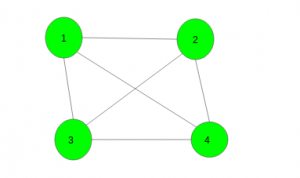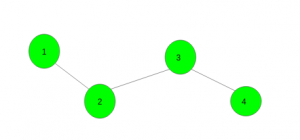给定一个有N个顶点的连通图。任务是从图中选择 k(k 必须小于或等于 n/2,不一定是最小值)个顶点,以便所有这些选定的顶点都连接到至少一个未选定的顶点。如果有多个答案,请打印其中任何一个。
例子:
Input :

Output : 1
Vertex 1 is connected to all other non selected vertices. Here
{1, 2}, {2, 3}, {3, 4}, {1, 3}, {1, 4}, {2, 4} are also the valid answers
Input :

Output : 1 3
Vertex 1, 3 are connected to all other non selected vertices. {2, 4} is also a valid answer.
有效的方法:一种有效的方法是使用简单的 dfs 或 bfs函数找到偶数级和奇数级的顶点。然后,如果奇数级别的顶点小于偶数级别的顶点,则打印奇数级别的顶点。否则,打印偶数级顶点。
下面是上述方法的实现:
C++
// C++ program to find K vertices in
// the graph which are connected to at
// least one of remaining vertices
#include
using namespace std;
#define N 200005
// To store graph
int n, m, vis[N];
vector gr[N];
vector v[2];
// Function to add edge
void add_edges(int x, int y)
{
gr[x].push_back(y);
gr[y].push_back(x);
}
// Function to find level of each node
void dfs(int x, int state)
{
// Push the vertex in respected level
v[state].push_back(x);
// Make vertex visited
vis[x] = 1;
// Traverse for all it's child nodes
for (auto i : gr[x])
if (vis[i] == 0)
dfs(i, state ^ 1);
}
// Function to print vertices
void Print_vertices()
{
// If odd level vertices are less
if (v[0].size() < v[1].size()) {
for (auto i : v[0])
cout << i << " ";
}
// If even level vertices are less
else {
for (auto i : v[1])
cout << i << " ";
}
}
// Driver code
int main()
{
int n = 4, m = 3;
// Add edges
add_edges(1, 2);
add_edges(2, 3);
add_edges(3, 4);
// Function call
dfs(1, 0);
Print_vertices();
return 0;
} Java
// Java program to find K vertices in
// the graph which are connected to at
// least one of remaining vertices
import java.util.*;
class GFG
{
static final int N = 200005;
// To store graph
static int n, m;
static int[] vis = new int[N];
static Vector[] gr = new Vector[N];
static Vector[] v = new Vector[2];
// Function to add edge
static void add_edges(int x, int y)
{
gr[x].add(y);
gr[y].add(x);
}
// Function to find level of each node
static void dfs(int x, int state)
{
// Push the vertex in respected level
v[state].add(x);
// Make vertex visited
vis[x] = 1;
// Traverse for all it's child nodes
for (int i : gr[x])
{
if (vis[i] == 0)
{
dfs(i, state ^ 1);
}
}
}
// Function to print vertices
static void Print_vertices()
{
// If odd level vertices are less
if (v[0].size() < v[1].size())
{
for (int i : v[0])
{
System.out.print(i + " ");
}
}
// If even level vertices are less
else
{
for (int i : v[1])
{
System.out.print(i + " ");
}
}
}
// Driver code
public static void main(String[] args)
{
n = 4;
m = 3;
for (int i = 0; i < N; i++)
{
gr[i] = new Vector();
}
for (int i = 0; i < 2; i++)
{
v[i] = new Vector();
}
// Add edges
add_edges(1, 2);
add_edges(2, 3);
add_edges(3, 4);
// Function call
dfs(1, 0);
Print_vertices();
}
}
// This code is contributed by 29AjayKumar Python3
# Python3 program to find K vertices in
# the graph which are connected to at
# least one of remaining vertices
N = 200005
# To store graph
n, m, =0,0
vis=[0 for i in range(N)]
gr=[[] for i in range(N)]
v=[[] for i in range(2)]
# Function to add edge
def add_edges(x, y):
gr[x].append(y)
gr[y].append(x)
# Function to find level of each node
def dfs(x, state):
# Push the vertex in respected level
v[state].append(x)
# Make vertex visited
vis[x] = 1
# Traverse for all it's child nodes
for i in gr[x]:
if (vis[i] == 0):
dfs(i, state ^ 1)
# Function to prvertices
def Print_vertices():
# If odd level vertices are less
if (len(v[0]) < len(v[1])):
for i in v[0]:
print(i,end=" ")
# If even level vertices are less
else:
for i in v[1]:
print(i,end=" ")
# Driver code
n = 4
m = 3
# Add edges
add_edges(1, 2)
add_edges(2, 3)
add_edges(3, 4)
# Function call
dfs(1, 0)
Print_vertices()
# This code is contributed by mohit kumar 29C#
// C# program to find K vertices in
// the graph which are connected to at
// least one of remaining vertices
using System;
using System.Collections.Generic;
class GFG
{
static readonly int N = 200005;
// To store graph
static int n, m;
static int[] vis = new int[N];
static List[] gr = new List[N];
static List[] v = new List[2];
// Function to add edge
static void add_edges(int x, int y)
{
gr[x].Add(y);
gr[y].Add(x);
}
// Function to find level of each node
static void dfs(int x, int state)
{
// Push the vertex in respected level
v[state].Add(x);
// Make vertex visited
vis[x] = 1;
// Traverse for all it's child nodes
foreach (int i in gr[x])
{
if (vis[i] == 0)
{
dfs(i, state ^ 1);
}
}
}
// Function to print vertices
static void Print_vertices()
{
// If odd level vertices are less
if (v[0].Count < v[1].Count)
{
foreach (int i in v[0])
{
Console.Write(i + " ");
}
}
// If even level vertices are less
else
{
foreach (int i in v[1])
{
Console.Write(i + " ");
}
}
}
// Driver code
public static void Main(String[] args)
{
n = 4;
m = 3;
for (int i = 0; i < N; i++)
{
gr[i] = new List();
}
for (int i = 0; i < 2; i++)
{
v[i] = new List();
}
// Add edges
add_edges(1, 2);
add_edges(2, 3);
add_edges(3, 4);
// Function call
dfs(1, 0);
Print_vertices();
}
}
// This code is contributed by Rajput-Ji Javascript
输出:
2 4时间复杂度: O(V+E)
其中 V 是顶点数,E 是图中的边数。
如果您希望与专家一起参加现场课程,请参阅DSA 现场工作专业课程和学生竞争性编程现场课程。